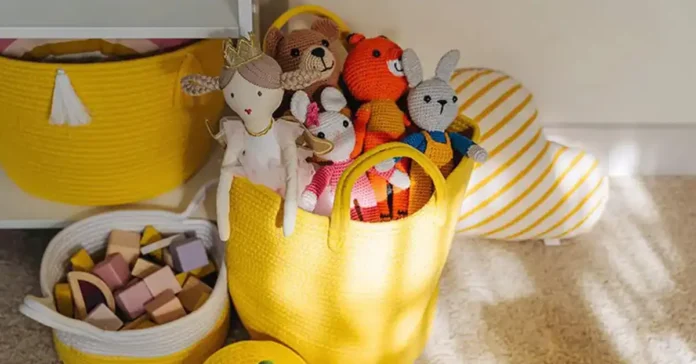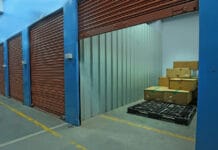Creating a safe and playful children’s room is essential for their well-being and happiness. Start by decluttering the space to remove unnecessary items that could cause accidents. Use box storage to organize toys, books, and clothes, making it easy for kids to find their things. During relocation, consider using self-storage or utility lockers to temporarily store items you don’t need right away. This will help keep the room spacious and free from clutter.
Choose child-friendly furniture with rounded edges and secure heavy items to the wall to prevent tipping. Incorporate bright colours and playful decor to create a joyful atmosphere that encourages creativity and play. With the right balance of safety and fun, you can design a children’s room that both kids and parents will love. Simple organization and thoughtful planning make all the difference in creating this special space.
Children’s Room – An Overview
To create a safe and playful children’s room, start by securing furniture to walls to prevent tipping. Use soft, non-toxic materials for rugs and cushions. Incorporate box storage for toys and books to keep the floor clutter-free. Choose low, easy-to-reach shelves to encourage kids to put things away. Add fun elements like a chalkboard wall or a reading nook. Use bright colours and themed decor to make the space inviting. For safety, ensure electrical outlets are covered and avoid placing heavy items on high shelves. Rotate toys to keep the room fresh and exciting.
Before you start, keep the following things in mind to encourage your kids to clean up, declutter and organise their rooms:
1. Talk about how every item has “A Home”
Children are excellent at helping us find items for our houses. Helping the children understand that each of their toys has its own ‘Home’ gives them a chance to tidy up after themselves. According to professional organizing coach Maeve Richmond, children naturally personify things. Therefore, when organizing with children, I ask questions like, “Do you want this object to live with you?” or “Where should we give this a home?”
“Put that away ” is a phrase we all heard growing up and seems demeaning. Try asking, “Can we place that where it lives?” instead. Richmond claims that by using this creative linguistic change, the work is positively reframed.
If you are looking for extra storage for your children’s room other than boxes and baskets, consider furniture pieces that enable you to keep everything in one location. Such storage solutions are fantastic. All your kids’ clothes may be kept in a closet organiser, and the toys can be kept in a different closet or even a cabinet to hold both items.
2. Let go of Unwanted Items
According to a recent survey by the National Association of Child Care Resource & Referral Agencies (NACCRRA), half of the parents surveyed said their children feel bad about giving up something they do not need. Kids often experience this guilt because they are taught from an early age that wasting anything is immoral. What happens when you begin encouraging your youngster to let go of no longer necessary possessions?
According to Maeve Richmond, children may find the volume to be highly overwhelming. “But most children are unaware that declining offers of things they don’t want is acceptable. To continue using positive language when it comes to decluttering, I like to try to create scenarios in which we donate goods to charities. We’re not just getting rid of the thing but giving it a new home.”
Help your kids realise that it is acceptable to part with possessions they no longer use if you want them to live a life free of clutter.
3. Reinforce their Routine with Cubbies
Toys and other stuff can be artfully arranged in cubbies or cupboards throughout children’s rooms. Cubbies help establish order and reinforce daily routines. They can be used in any location, including the kitchen, playroom, and foyer.
Another simple method for organising toys and games is to use bins. You can use plastic bins, baskets, boxes, or crates to store several types of toys. While some youngsters enjoy sorting through these bins, others would rather just take whatever they see. Using bins teaches children to pay attention and helps them develop their fine motor abilities.
4. Define boundaries with Decor
Room organisation for your children should be a continuous activity. Ensuring that the materials, patterns, and colours utilised in each space coordinate is crucial.
Even though it might seem obvious, this process includes keeping your children’s bedroom tidy. It is challenging to teach your kids self-organization when your rooms are a mess. Additionally, it is more difficult for kids to concentrate on learning new things when there is clutter everywhere. Consider employing storage alternatives like wall hooks, pegboards, and cubbies if you are looking for cheap or quick ways to organise your kids’ bedrooms. These tools are affordable and have a tonne of storage. Additionally, they enhance any room’s aesthetics and character.
Just as much as we change every day, so do our likes and dislikes. Children, too, are prone to have new favourites every single day – favourite colours, superheroes, animals, and much more. As they grow, they tend to outgrow certain decor and, at times, things they like. This is where a self-storage unit like Self Storage India can be handy. You can store the items and furniture that no longer match your child’s newfound style but still have sentimental value. Once you have a storage unit, you can decide whether to donate or throw away the items that are no longer in use.
5. Lead by example
Children see everything we do and pick up knowledge from us. Lead by example when it comes to organizing children. First, clean up your own space. Then, give your home a thorough cleaning. Finally, teach your children how to recycle and properly dispose of waste.
Children often pick up new skills by watching how others behave. Being a good example of order and keeping regular cleanliness is a great weapon. Being organised with your personal belongings is far more helpful than encouraging your kids to tidy up after themselves. Every day, your children see how you behave, so start instructing them when they are still small and susceptible to learning.
Even though it may appear infinite, your child’s room is another obstacle waiting to be tackled. Do not be discouraged. The first step to a successful organisation is knowing what your child owns and whether he or she wants the items anymore. All your child’s items should be categorised before you decide what stays and what goes. After deciding what to keep, you will need a system for keeping everything together so your child can access it and put it back up again. It all boils down to balance when organising children’s bedrooms. Most important of all, do not forget to have fun!
Final Words for Children’s Room
Creating a safe and playful children’s room is all about thoughtful planning and smart organization. By using box storage and easy-to-reach shelves, you can keep the space clutter-free while making it fun and accessible for your kids. Safety should always come first, so ensure furniture is secured, outlets are covered, and soft materials are used throughout the room. Adding playful elements like bright colours, themed decor, and a cosy reading nook can spark creativity and joy.
With these simple tips and tricks, you can design a room that meets your child’s needs and provides a safe and enjoyable environment for them to grow, learn, and play.
FAQs for Children’s Room
A1: Secure heavy furniture to the walls, cover electrical outlets, and use soft, non-toxic materials to minimize injury risks.
A2: Box storage, low shelves, and baskets are great for keeping toys, books, and clothes organized and easily accessible.
A3: Regularly sort through toys and clothes, removing items your child no longer uses. Store extra items in self-storage or utility lockers.
A4: To make the space more inviting, use bright colours and themed decor, and add a cosy reading nook or a chalkboard wall.
A5: Install safety locks on windows, secure furniture to prevent tipping, and use non-slip rugs to prevent falls.
Q6: How can I involve my child in organizing their room?
A6: Let your child help choose storage options and decorate the space. This makes them more likely to keep the room tidy.
A7: Choose child-sized furniture with rounded edges and avoid placing heavy items on high shelves to ensure safety.
A8: Store seasonal items or toys that aren’t in use in a self-storage unit to keep the room uncluttered and spacious.
Q9: How do I keep the room clutter-free?
A9: Rotate toys and books, keeping only a few out at a time. Regularly declutter by donating or storing items your child no longer uses.
A10: A safe environment protects your child from accidents, while a playful space encourages creativity and learning.








